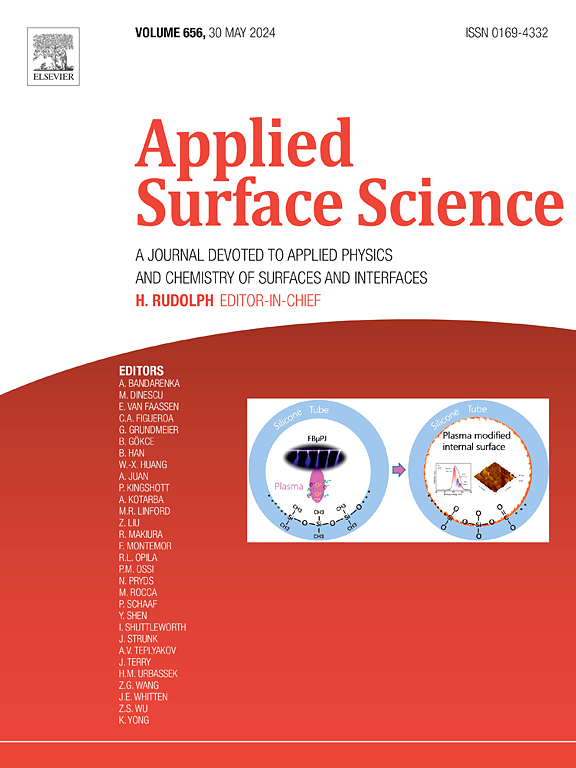高质量负载氮化钒/掺n氧化石墨烯阴极用于快速稳定的锌离子存储
IF 6.3
2区 材料科学
Q2 CHEMISTRY, PHYSICAL
引用次数: 0
摘要
氮化钒(VN)由于其丰富的储量、多价态和较高的理论比容量在水锌离子电池(AZIBs)中引起了广泛的关注。然而,在azib中直接利用VN仍然面临着巨大的挑战,包括动力学迟缓、低质量负载和次优循环稳定性。本文采用了一种精巧的方法,通过氮掺杂还原氧化石墨烯(VN/N-rGO)复合和3D打印技术来提高VN的电化学性能。设计的导电网络和分层多孔结构增强了电极的反应动力学,抑制了电极的溶解,从而提高了循环稳定性。制备的电极具有529.8mAh g- 1的可逆容量,良好的长周期稳定性(在8.0 A g- 1下1000次循环后261.6mAh g- 1)和良好的倍率性能。此外,通过材料挤压3D打印构建了高质量负载VN/N-rGO电极(~ 13 mg cm−2),电极仍然显示出390.2mAh g−1的高可逆容量。对VN与Zn离子的电化学反应机理进行了广泛的研究,表明VN在第一个循环中不可逆地转化为Zn3(OH)2V2O7(H2O)2,在随后的循环中,Zn离子可逆地插入/从Zn3(OH)2V2O7(H2O)2的中间层中析出。这项工作表明,VN在azib中具有作为高质量负载阴极的巨大潜力。本文章由计算机程序翻译,如有差异,请以英文原文为准。

High-Mass-Loading vanadium nitride /N-Doped rGO cathode for fast and stable Zinc-Ion storage
Vanadium nitride (VN) has sparked much interest because of the abundant reserves, multivalent states, and high theoretical specific capacity in aqueous zinc-ion batteries (AZIBs). However, the direct utilization of VN in AZIBs is still huge challenges including sluggish kinetics, low-mass-loading and suboptimal cycling stability. Herein, an exquisite method is employed to enhance the electrochemical performance via compositing of VN with nitrogen-doped reduced graphene oxide (VN/N-rGO) and 3D printing technique. The designed conductive network and hierarchical porous structure enhance the reaction kinetics of the electrode and inhibit its dissolution, thereby improving cycling stability. The fabricated electrodes demonstrate superior reversible capacity of 529.8mAh g−1, excellent long-cycle stability (261.6mAh g−1 after 1000 cycles at 8.0 A g−1) and good rate capability. Furthermore, the high-mass-loading VN/N-rGO electrodes (∼13 mg cm−2) are constructed through material extrusion 3D printing, and the electrodes still display a high reversible capacity of 390.2mAh g−1. The electrochemical reaction mechanism of VN with Zn ions has been extensively studied, indicating that VN irreversibly transforms into Zn3(OH)2V2O7(H2O)2 during first cycle, and Zn ions reversibly insert into/extract from the interlayer of Zn3(OH)2V2O7(H2O)2 during the following cycles. This work demonstrates that VN holds significant potential as high-mass-loading cathode in AZIBs.
求助全文
通过发布文献求助,成功后即可免费获取论文全文。
去求助
来源期刊

Applied Surface Science
工程技术-材料科学:膜
CiteScore
12.50
自引率
7.50%
发文量
3393
审稿时长
67 days
期刊介绍:
Applied Surface Science covers topics contributing to a better understanding of surfaces, interfaces, nanostructures and their applications. The journal is concerned with scientific research on the atomic and molecular level of material properties determined with specific surface analytical techniques and/or computational methods, as well as the processing of such structures.
 求助内容:
求助内容: 应助结果提醒方式:
应助结果提醒方式:


